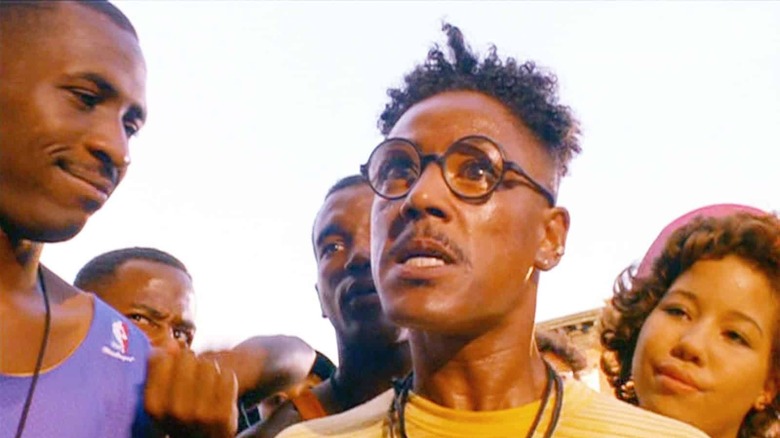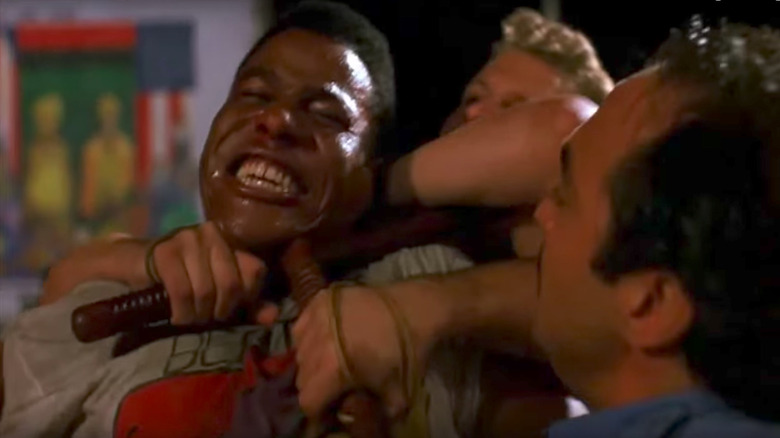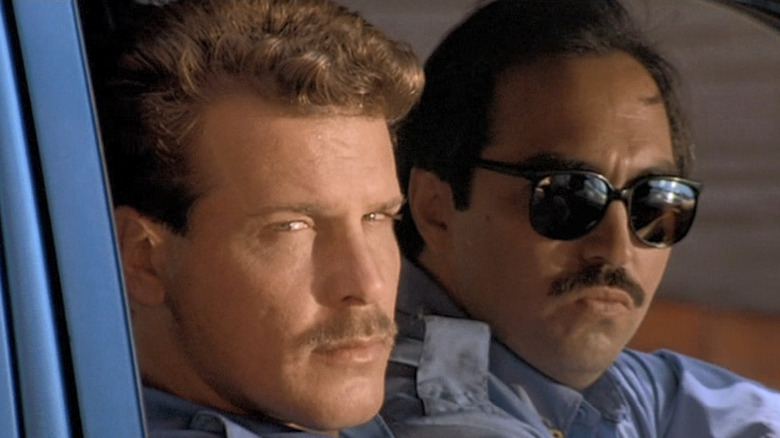Spike Lee's Do The Right Thing Riot Scene Wasn't Easy For Giancarlo Esposito
Great performances often come from actors stepping out of their comfort zones. For Giancarlo Esposito, things got all too real in Spike Lee's intense, stylistic 1989 film, "Do The Right Thing."
When you watch the understated Gus Fring in "Breaking Bad" or the callous Moff Gideon in "The Mandalorian," it's easy to forget that Esposito played the frenetic, provocative character Buggin' Out in Lee's eye-opening "Do the Right Thing." In a film marked with nihilism, Esposito's character bounds about the entire movie, rife with purpose.
The film explores themes of oppression and institutional racism through the eyes of those living in the Bedford-Stuyvesant New York neighborhood on the hottest day of the year. Sadly, it foreshadows plenty of actual events to come, culminating in a police beating that leaves neighborhood institution Radio Raheem (Bill Nunn) dead. The film (and the Radio Raheem character) challenges audiences to choose between love and hate. Lee presents two sides of the coin in the fight for civil rights and social justice: Passivity or violence.
For Esposito, the movie's climactic riot scene was especially tough to shoot.
New York was in turmoil
Los Angeles might have taken center stage for tumultuous race relations in the 1990s after the Rodney King beating, but in the decade prior, New York City dominated the headlines. In 1982, a white mob beat a Black transit worker named Willie Turks to death. In 1986, a Black teenager named Michael Griffiths was beaten to death by a white gang. And just before the film's release, five innocent Black and Latino kids were convicted of assaulting a white woman jogging in Central Park; they spent years in prison until they were eventually exonerated.
"We were very nervous. I mean, we're doing a movie about racial tension in New York when things aren't really good," Esposito recalled in an interview with The Guardian. "Spike decided to tell that story."
"Do The Right Thing" captures the growing frustration in a diverse but struggling neighborhood. Throughout the entire movie, Esposito's character, Buggin' Out, is confrontational with the Italian American owner of the neighborhood pizza shop, Sal (Danny Aiello), and the film's climactic scene (which left the neighborhood in shambles) hit particularly close to home for Esposito. The actor said:
"The riot stuff at the end was scary. When you have to get physical, something takes over. There were some intense moments, with people getting in touch with how they really felt. With Danny Aiello, who played Sal, I was cursing him, and he was cursing me, and all of our lives flashed past us. We ended up crying in each other's arms because we'd said some horrible things to each other."
'Spike Lee had done an almost impossible thing'
With "Do The Right Thing," Lee tells New York's story, and so much more. There's an underlying message in the film that the American Dream can be had, but only for those in the right neighborhood. Sal's Pizzeria and a Korean market both struggle in the predominantly black Bed-Stuy neighborhood. The tension boils over when the residents watch helplessly as the police beat and kill Radio Raheem. The neighborhood eventually turns on Sal and almost turns on the Koreans as well. From Rodney King to George Floyd, it's a scene that has now played out too many times in America.
"Spike Lee had done an almost impossible thing. He'd made a movie about race in America that empathized with all the participants," Roger Ebert wrote in his review of the film. "He didn't draw lines or take sides but simply looked with sadness at one racial flashpoint that stood for many others."
Discrimination in the film is both explicit and implicit. Some instances are obvious, like white police officers driving slowly past Black men on the street, clearly profiling them. Other times it comes via dialogue, like when Da Mayor (Ossie Davis) says to the Korean shop owner, "This ain't China or Korea or wherever you come from," or when Mookie (Spike Lee pulling triple duty as writer, director, and star) tells Tina's mother, "I want my son to speak English. It's bad enough his name is Hector."
While the intensity of the riot sequence might have made him uncomfortable, Esposito believed that audiences connected with the realism of the film. "The whole look and rhythm of the movie is like a heightened reality," he said. "I think that's what makes it so special."


